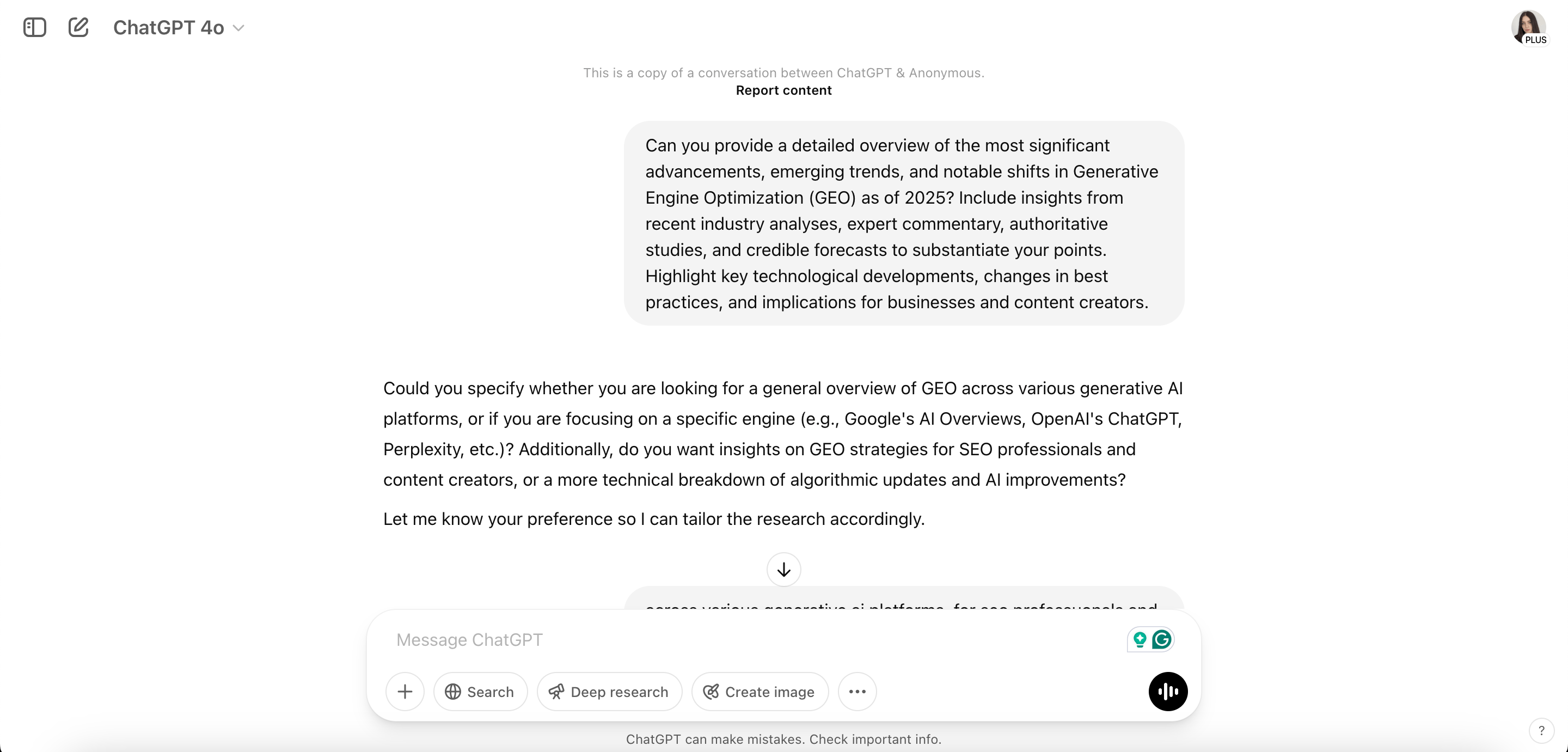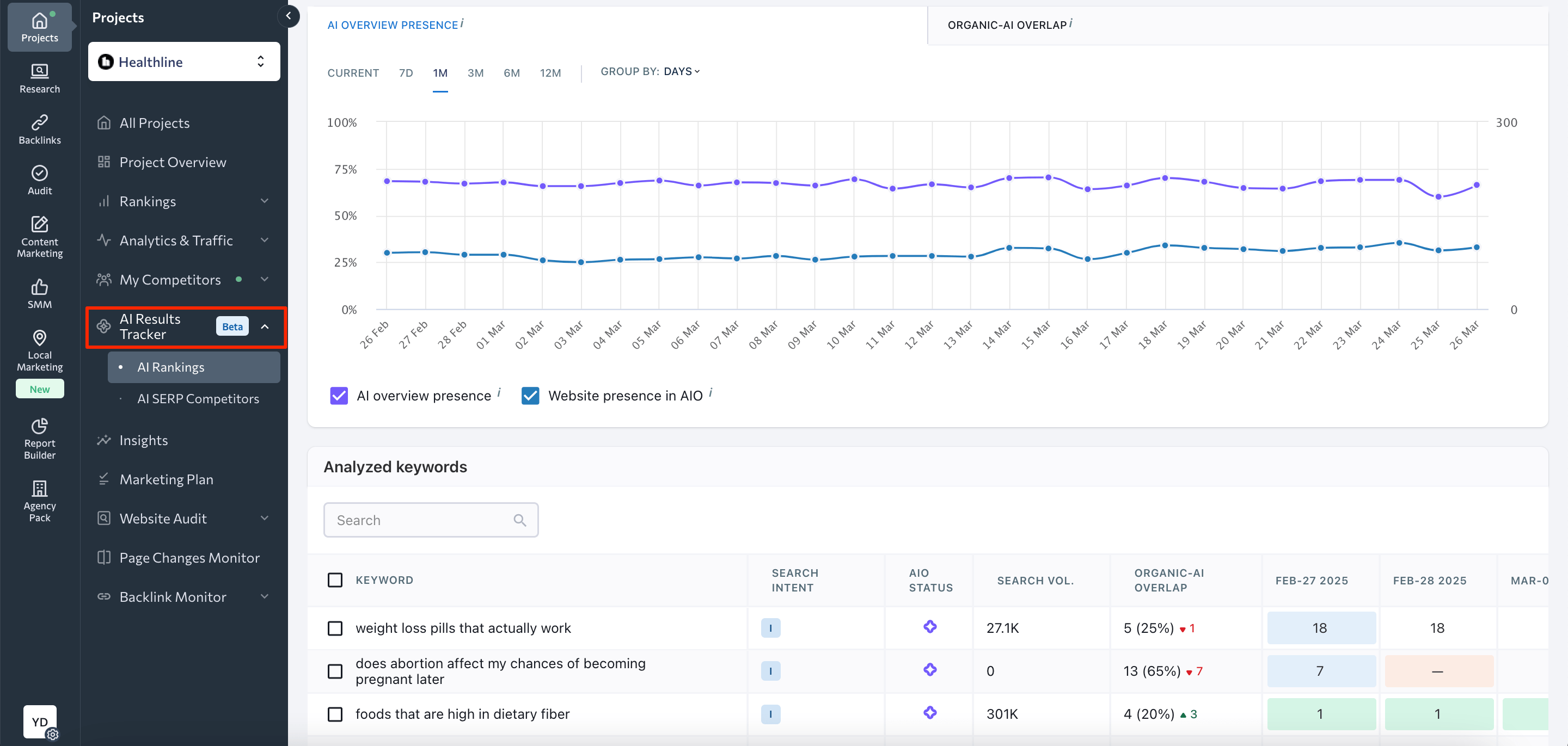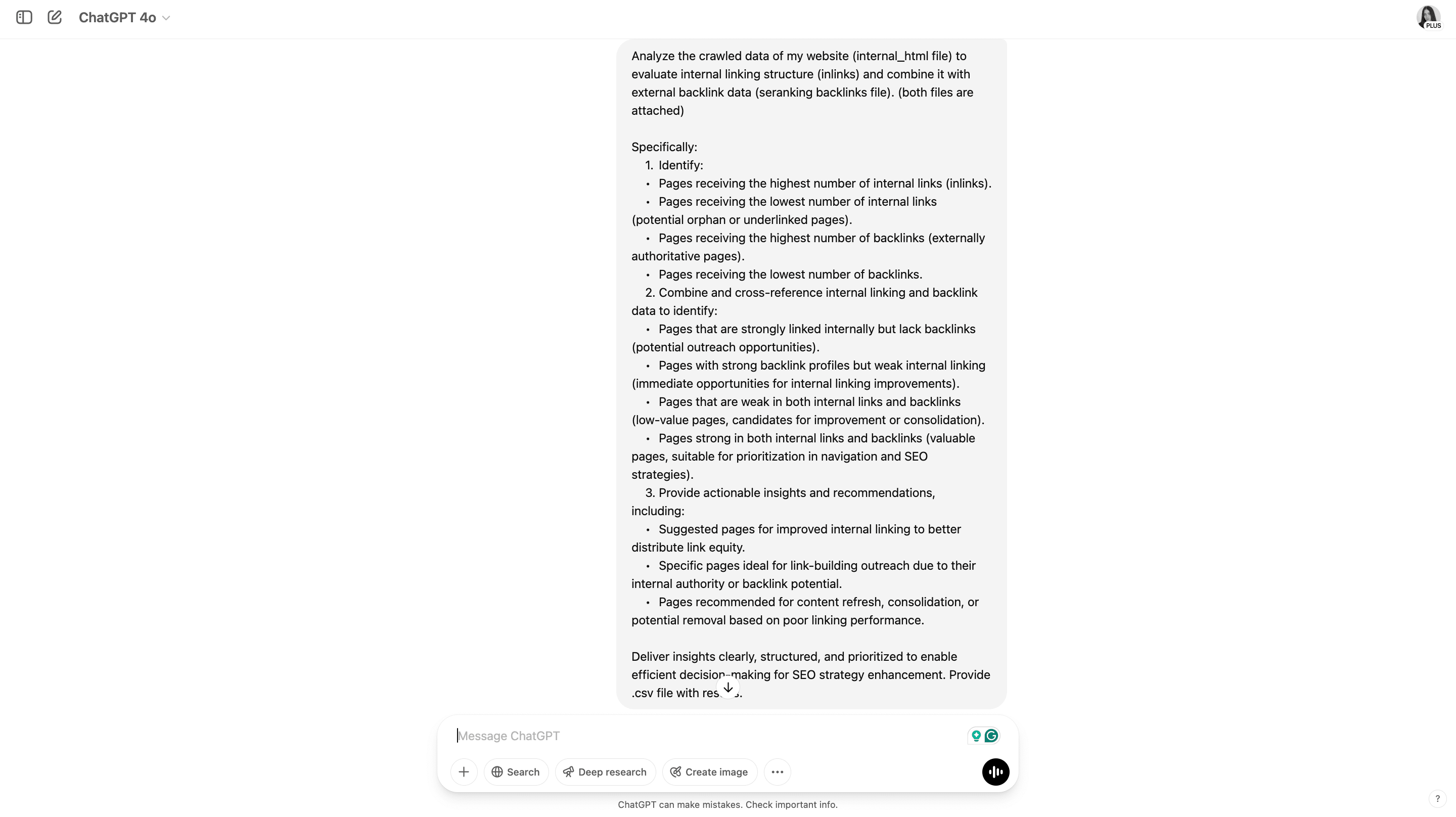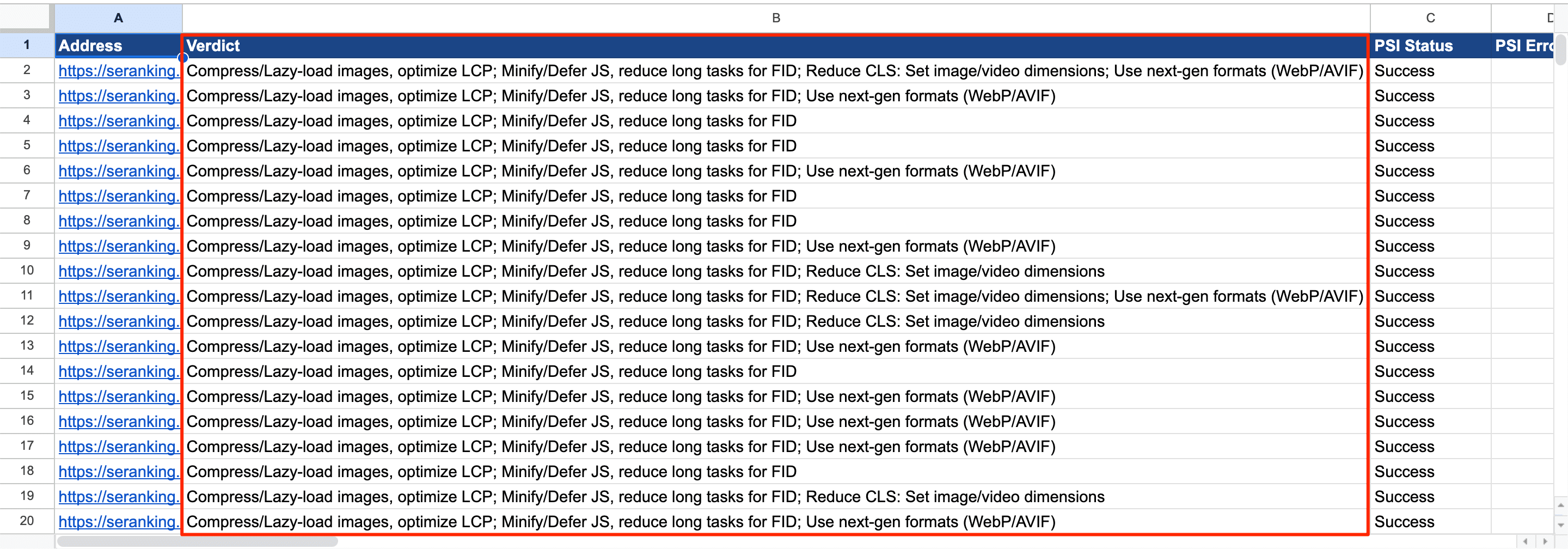Deep Research for SEO: How to Use AI for Advanced SEO Insights
New AI tools and modes are dropping almost every week, with each new release quickly fading into the digital background. But every now and then, something cuts through the static. Something that doesn’t just tweak the way we work, but transforms it.
ChatGPT’s new Deep Research mode is one of those rare standouts. It’s built for automating complex research, finding insights at scale, and simplifying the kind of analysis that usually eats up your day. Sure, it’s not a full replacement for your go-to SEO tools or hands-on analysis, but it works great alongside them (helping you move quicker without sacrificing depth).
This article covers the areas in SEO where Deep Research can make a real difference. We’ll also explain how to start putting it to work.
-
ChatGPT’s Deep Research mode is an advanced feature that automates complex, multi-step research tasks. It autonomously gathers data from the web and synthesizes it into detailed reports.
-
Deep Research lets you compare competitors by domain authority, traffic, keyword rankings, and on-page SEO (using data from online sources). It delivers tailored insights, like spotting content gaps and finding link opportunities, to sharpen your SEO strategy.
-
For topical research, Deep Research pinpoints rising keywords, content angles your competitors haven’t covered, and questions real users are asking. It achieves this by analyzing SERP shifts, expert publications, forum discussions, and news trends.
-
By reviewing internal linking patterns and backlink profiles side by side, Deep Research identifies areas for improvement (like pages needing more backlinks, high-authority pages that should be used to boost others, or valuable content that’s buried too deep in your site structure).
-
To get the most out of Deep Research, provide specific prompts, break larger tasks into manageable parts, and use established SEO tools to cross-check findings. Note that complex queries may take 15-30 minutes to process, so plan accordingly.
-
At this stage, Deep Research doesn’t fully match the accuracy required for SEO workflows, so traditional tools remain essential.
What is ChatGPT’s Deep Research feature?
Deep Research is an advanced agentic capability introduced by OpenAI in early 2025. It functions as an AI research assistant that can autonomously conduct multi-step research on the web and synthesize findings into detailed reports.
In practical terms, Deep Research goes beyond the ChatGPT-4o experience. Instead of answering with just what it “knows” or a quick web result, it performs an in-depth investigation across numerous sources, then delivers a comprehensive, well-structured response (often with references).
For professionals using AI for SEO, this means they can delegate complex research tasks (like competitor audits and topical research) to ChatGPT, then receive detailed, analyst-style insights.
How does Deep Research differ from other AI tools?
We’ll jump into how Deep Research helps with SEO tasks soon, but first, let’s look at how Deep Research compares with other AI research tools, specifically DeepSeek and xAI’s Grok.
ChatGPT’s Deep Research
Highly structured, multi-source reports. Ideal for SEO, content strategy, and academic tasks
DeepSeek’s DeepThink
Moderate – logical step-by-step reasoning; better for technical Q&A than extensive research
Grok 3’s Deep Research
Moderate – prioritizes speed and summarization; lacks depth for long-form SEO analysis
ChatGPT’s Deep Research
Long-form, polished responses with tables, lists, and analysis
DeepSeek’s DeepThink
Mostly paragraph-based with some logical structure
Grok 3’s Deep Research
Executive summaries with key points first; good for brief reports
ChatGPT’s Deep Research
Competitor research, topical research, keyword research, and SEO trend analysis
DeepSeek’s DeepThink
Technical breakdowns, logical problem-solving, academic or math-based search queries
Grok 3’s Deep Research
Trend tracking, brand monitoring, audience research, quick takes on current events or social sentiment
ChatGPT’s Deep Research
Yes – pulls recent data during research, offering current snapshots of SERPs, topics, and backlink profiles
DeepSeek’s DeepThink
No – static model without access to web updates
Grok 3’s Deep Research
Yes – real-time web and X/Twitter context; helpful for rapid change tracking
ChatGPT’s Deep Research
Yes – supports data analysis from uploaded CSVs, PDFs, or structured content
DeepSeek’s DeepThink
No – file uploads not supported
Grok 3’s Deep Research
Limited – accepts code and can process data manually, but is not optimized for file-based workflows
ChatGPT’s Deep Research
Yes – sources referenced throughout; outputs often include citations or summaries of consulted documents
DeepSeek’s DeepThink
Partial – will provide reasoning or examples, but doesn’t automatically cite sources
Grok 3’s Deep Research
Yes – often includes source links, though quality and reliability of citations may vary
Highly structured, multi-source reports. Ideal for SEO, content strategy, and academic tasks
Moderate – logical step-by-step reasoning; better for technical Q&A than extensive research
Moderate – prioritizes speed and summarization; lacks depth for long-form SEO analysis
Long-form, polished responses with tables, lists, and analysis
Mostly paragraph-based with some logical structure
Executive summaries with key points first; good for brief reports
Competitor research, topical research, keyword research, and SEO trend analysis
Technical breakdowns, logical problem-solving, academic or math-based search queries
Trend tracking, brand monitoring, audience research, quick takes on current events or social sentiment
Yes – pulls recent data during research, offering current snapshots of SERPs, topics, and backlink profiles
No – static model without access to web updates
Yes – real-time web and X/Twitter context; helpful for rapid change tracking
Yes – supports data analysis from uploaded CSVs, PDFs, or structured content
No – file uploads not supported
Limited – accepts code and can process data manually, but is not optimized for file-based workflows
Yes – sources referenced throughout; outputs often include citations or summaries of consulted documents
Partial – will provide reasoning or examples, but doesn’t automatically cite sources
Yes – often includes source links, though quality and reliability of citations may vary
Each tool has its strengths, but Deep Research stands out with its structured outputs, real-time data depth, and the ability to tackle complex SEO tasks like competitor analysis and topical research.
- We recently conducted a study comparing how ChatGPT, Perplexity, Google, and Bing present content, choose sources, and support their answers. You can explore the key insights here.
- If you’re interested in how ChatGPT, DeepSeek, and other AIOs handle YMYL (Your Money or Your Life) topics—especially sensitive areas like health, politics, finance, and legal issues—be sure to check out our in-depth research here.
Now, let’s shift focus to analyzing ChatGPT’s specific modes in detail.
Since ChatGPT now comes in various “modes” or agents, it’s important to clarify what makes Deep Research unique. The key differences between Deep Research and other ChatGPT models (like standard ChatGPT, the ChatGPT Operator, or SearchGPT) boil down to autonomy, depth, and use-case focus.
Below is an SEO use-case comparison between Deep Research, OpenAI’s standard ChatGPT, and Operator (an agent that can search the web to perform trivial tasks):
Standard ChatGPT
❌ Not possible (no current web data, only general tips).
ChatGPT’s Operator
⚠️ Possible but tedious: Can visit competitor sites one by one if instructed; tends to require many follow-up prompts and copying.
ChatGPT’s Deep Research
✅ Highly effective: Autonomously compares multiple competitors, gathering data on rankings, content, backlinks, etc., and delivers a thorough report (our test ran ~32 pages).
Standard ChatGPT
❌ Not possible (can’t access external URLs).
ChatGPT’s Operator
⚠️ Slow manual process: Opens each link via browsing; prone to crashing after several checks, needs user supervision.
ChatGPT’s Deep Research
✅ Automated: Reads a list of URLs and outputs the ones containing your backlink. In our testing, it checked ~100 URLs in one go, much faster than manual checks (though accuracy checks are needed).
Standard ChatGPT
⚠️ Historical knowledge only: Might list popular keywords from previous years or guess current trends.
ChatGPT’s Operator
✅ Can search for “trending keywords [date]”: But you’ll need to manually guide it through the results or provide access credentials for specific SEO tools (like SE Ranking’s Keyword Research).
ChatGPT’s Deep Research
✅ Researches real-time trends: Fetches latest data from news, forums, and tools to list current trending keywords (with search volumes and difficulty if available).
Standard ChatGPT
❌ Not possible (no site crawl data input).
ChatGPT’s Operator
⚠️ Limited: Could perhaps analyze one page at a time via browsing.
ChatGPT’s Deep Research
✅ Data-driven: Can take in your site’s crawl data and backlink data, then cross-analyze it for link opportunities (internal vs external link gaps) and give detailed recommendations.
Standard ChatGPT
⚠️ Based on training data: Might recall generic top sites for a query (unreliable).
ChatGPT’s Operator
✅ Direct: Performs live searches on Google/Bing/DuckDuckGo and copies top results step-by-step, if asked.
ChatGPT’s Deep Research
✅ Autonomous: Executes the search query, scans the top results and snippets, and compiles them into a summary or table (with minimal prompting).
❌ Not possible (no current web data, only general tips).
⚠️ Possible but tedious: Can visit competitor sites one by one if instructed; tends to require many follow-up prompts and copying.
✅ Highly effective: Autonomously compares multiple competitors, gathering data on rankings, content, backlinks, etc., and delivers a thorough report (our test ran ~32 pages).
❌ Not possible (can’t access external URLs).
⚠️ Slow manual process: Opens each link via browsing; prone to crashing after several checks, needs user supervision.
✅ Automated: Reads a list of URLs and outputs the ones containing your backlink. In our testing, it checked ~100 URLs in one go, much faster than manual checks (though accuracy checks are needed).
⚠️ Historical knowledge only: Might list popular keywords from previous years or guess current trends.
✅ Can search for “trending keywords [date]”: But you’ll need to manually guide it through the results or provide access credentials for specific SEO tools (like SE Ranking’s Keyword Research).
✅ Researches real-time trends: Fetches latest data from news, forums, and tools to list current trending keywords (with search volumes and difficulty if available).
❌ Not possible (no site crawl data input).
⚠️ Limited: Could perhaps analyze one page at a time via browsing.
✅ Data-driven: Can take in your site’s crawl data and backlink data, then cross-analyze it for link opportunities (internal vs external link gaps) and give detailed recommendations.
⚠️ Based on training data: Might recall generic top sites for a query (unreliable).
✅ Direct: Performs live searches on Google/Bing/DuckDuckGo and copies top results step-by-step, if asked.
✅ Autonomous: Executes the search query, scans the top results and snippets, and compiles them into a summary or table (with minimal prompting).
See the articles below for a closer look at ChatGPT’s modes:
Overall, we found that Deep Research is far more self-sufficient and thorough in SEO research tasks than ChatGPT’s other modes.
How to use ChatGPT’s Deep Research for SEO
Let’s now explore some Deep Research use cases and how to get the most out of this tool in each.
Competitor analysis
Traditionally, you would use multiple tools for competitor analysis – one for traffic estimates, one for backlinks, one for content analysis. Then you would manually compile the findings.
Deep Research is useful in that you can feed it a detailed prompt, list the competitors and all other aspects you care about, and then let it do the heavy lifting.
Here’s how:
1. Select the competitors you want to analyze, plus your website (preferably, 2-3 at a time to achieve the most comprehensive insights on each).
2. Define the SEO factors to compare: This could be domain authority/backlinks, top keywords/traffic, content marketing strategy, on-page SEO, and technical factors like site speed or mobile friendliness.
3. Craft a detailed prompt. It should be clear, specific, and structured to help guide ChatGPT’s Deep Research functionality. As an example, this is the prompt we used for our testing:

We made sure we were crystal clear about what we wanted in the prompt (competitor analysis) and why (to improve our site). The prompt was also very specific, detailing exact metrics (e.g., DA, PA, top keywords) and distinct competitors.
We also organized the prompt into distinct sections (like SEO performance, keyword strategy, backlink profile, and so on), each with specific sub-tasks.
Is it long? For sure. But keep in mind, longer and more specific prompts may lead to higher-quality responses.
4. Expect 5–30 minutes for Deep Research processes to finish processing the request and finalizing its output. It will do so in the background.
5. Check the report for insights and takeaways. Some of the insights you can expect from such Deep Research outputs include:
- Domain Authority & Backlinks: In our case, the report compared the domain strength of each competitor, noting that: “Competitor A has 177k referring domains with strong authority in the marketing niche, while Competitor B has 115k referring domains but from top-tier marketing blogs and even .edu sites.”
- Organic Traffic & Rankings: Deep Research can pull organic traffic estimates and highlight top-performing pages for each competitor. We even got it to identify search terms for which competitors (but not us) rank in the top 5 (highlighting existing keyword gaps or pages needing more attention due to lower rankings compared to competitors).
- Content Strategy: The report can examine how each competitor structures their content. For example, “Competitor A heavily focuses on long-form how-to guides (averaging 2,500 words) targeting broad keywords. Competitor B’s content strategy leans on data studies, which attract backlinks.”
- On-Page SEO and Technical factors: Deep Research can also inspect competitor pages’ title tags and meta descriptions, as well as their site speed and mobile friendliness. For example, it can point out that one competitor has schema markup for FAQs on multiple pages (helping them grab rich SERP features) or that another competitor’s site has faster load times according to PageSpeed Insights.
- Actionable Takeaways: Deep Research doesn’t just list facts – it provides structured insights. In our competitor analysis, it wrapped up with clear opportunities to boost high-intent content creation, enhance linkable assets, address content gaps, and grow social media engagement, all backed by specific examples and suggestions.
But even though Deep Research does a good job delivering practical insights, you’ll still need to validate them with reliable tools like SE Ranking’s Competitor Research tool. This is the best way to avoid skewed results and make decisions based on accurate, up-to-date information.
Topical research
Identifying relevant, high-performing topics and keyword opportunities is another area where ChatGPT Deep Research shines.
Instead of spending hours combing through forums, blogs, and keyword tools to figure out “what’s trending” or “what should I write about next,” you can ask Deep Research to do a deep dive on industry trends or emerging topics in your field. Here’s how:
1. Start with a clear, detailed prompt. To get a comprehensive overview, ask for a structured breakdown and explicitly request insights from recent industry analyses, expert commentary, authoritative studies, and credible forecasts:

2. If you want the response to dive into specific areas, like technology, trends, or practical applications, break down the prompt into sub-questions. For instance:
- “What are the most significant advancements in GEO (Generative Engine Optimization) in 2025?”
- “How have best practices for content creators evolved to optimize for AI-driven search?”
- “What emerging trends should an SEO specialist watch, and how might they impact content strategy?”
- “What do industry experts predict for GEO’s future?”
3. To make the response actionable (like identifying content ideas or best practices), include a request for examples or suggestions. For instance:
“Based on your analysis of GEO trends in 2025, suggest 3-5 blog topic ideas that would likely perform well in AI-driven search, and explain why each is a good fit.”
We used this approach to get Deep Research to respond with insights on key technological developments, emerging trends, business implications, expert opinions, and forecasts.
After analyzing Deep Research’s response, you can extract whatever is relevant to your content strategy.
For instance, if the report indicates that “how-to” content with structured steps performs well with generative search, you might prioritize creating more how-to guides and marking them up with HowTo schema. Or if it suggests certain new keyword opportunities (perhaps people asking very specific, long-tail keywords for AI searches), you can target those.
To see how those opportunities play out in Google search results, use SE Ranking’s AI Overviews Tracker. It lets you monitor the keywords appearing in AI Overviews, how their presence evolves, and the sources featured in AI snippets. Deep Research and SE Ranking are a great tool combo if you’re trying to get the complete picture, from research to real-world performance.

Combined internal linking and backlink insights
ChatGPT’s Deep Research can also assist by analyzing your internal link structure and backlink profile together, uncovering link-building opportunities you might overlook when reviewing them apart.
1. Collect & organize data. Use a crawler (e.g., Screaming Frog) to export a list of pages with their internal inlink counts. Separately, run a backlink check using tools like SE Ranking’s Backlink Checker to collect a list of pages from your site with external backlink data.
2. Clean and anonymize the data. Strip out unnecessary columns (e.g., crawl depth, domain trust score) to keep the input lean—focus only on URLs and link counts. Replace sensitive URLs with generic labels (e.g., “Homepage” or “Blog Post X”) if privacy is a concern. This also keeps the prompt size manageable.
3. Craft a clear, specific prompt and attach files with data collected on internal and external links. Here’s how our prompt looked:

Here’s what Deep Research was able to do with our data:
- Find pages with the strongest internal linking structure: For example, “the “Homepage” (the main entry point) and important hub pages like X, Y, Z each have 760+ internal links from unique pages.”
- Find pages with the weakest internal linking structure: Conversely, it identified pages barely linked internally – “Roughly 191 pages have extremely low internal link counts (3 or fewer incoming links). This group includes X orphaned pages (no internal links at all) and X pages linked only once or twice.”
- Analyze backlinks: Deep Research will also rank pages by backlinks. It might say “Your “Homepage” stands out with X external backlinks, and a few important product pages also have multiple backlinks, such as X page (10 backlinks) and Y page (6 backlinks). At the same time, out of 1000 crawled pages, only 80 had any backlinks at all – meaning around 92% have none.”
- Cross-reference internal vs external: Here’s where the real insight comes – combining the two data sets. The AI highlights pages with high internal links but low external links, and vice versa.
- Provide actionable recommendations: In our experiment, after identifying these patterns, Deep Research suggested specific actions, such as where to add internal links, which pages should be targeted for backlink outreach, and which ones lacked both internal and external links. Deep Research recommended preventing thin content issues and suggested we could accomplish this by updating pages with no linking signals or consolidating them with stronger pages.
Although its results are general and obvious, with broad recommendations and little specificity, OpenAI is still heading in the right direction.
The biggest issue with these kinds of analyses is that ChatGPT often refuses to generate result files for complex analyses (even after several requests). When it does, it usually includes only the first 10–15 rows (at least, in our case).
Backlink status monitoring
Keeping track of backlink health (i.e., whether backlinks are still live, have become no-follow, or got removed) is an ongoing chore for SEO pros and agencies.
Typically, one might use a backlink monitoring tool for this, but there are times you want a quick custom check (for example, after a big link-building campaign, or when inheriting a new client’s backlink list).
ChatGPT’s Deep Research can expedite the backlink verification process by automatically checking each URL to confirm your link’s presence. We tested this by asking Deep Research to go through a list of URLs (a CSV of backlinks) and mark each as “Exists” or “Doesn’t Exist” depending on whether the page still contains a link to our site.
Here is the process we followed and the outcome:
1. Prepare the backlink list: Collect and export the CSV file with backlink data using dedicated tools like SE Ranking’s Backlink Monitoring Tool.
2. Ensure the file has a column for Referring page URL and Status (exists, doesn’t exist) – this is the column the agent will fill for you.
3. Clearly prompt deep research. This is how we structured our prompt:
- In the attached CSV file, review each URL listed in Column A (“Referring Page URL”).
- Check whether the page contains a backlink to seranking.com.
- In Column B (“Status”), update the status for each URL as: “Exists” → If a backlink to seranking.com is found; “Doesn’t Exist” → If no backlink is found.
- Deliverable: The updated spreadsheet with backlink status for each URL. Please note that it’s better to check if the backlink exists in the source code.
4. Wait for a deep research execution. The agent will then visit each URL one by one and scan the content of each page for mentions of our website or any hyperlink pointing to it. This is what an SEO would do manually: open the link, Ctrl+F for the domain, and mark yes/no.
During our trial, we started by submitting nearly 1,000 URLs in one go—but that overloaded the tool, and the process didn’t complete. We resolved this by splitting the list into smaller chunks of about 100 URLs each. Deep Research managed these batches much more efficiently, returning the status for every URL in the group.

The speed was impressive: what could have taken a human a couple of hours (opening 100 links and checking) took the AI a fraction of that. Moreover, we didn’t have to babysit it. Deep Research can work through the list autonomously once prompted.
For agencies, this use of Deep Research can be a huge time-saver in reporting. You can integrate a backlink check into your monthly SEO reports: just run the client’s backlink list through ChatGPT’s Deep Research and quickly flag the ones that disappeared.
Even if you use an automated tool, the AI can provide a nice plain-English summary of “X% of backlinks are active, Y were found removed this month, mostly from Site A and Site B.” You can then focus on how to handle those lost links.
Note: The AI’s output was typically pretty accurate, but we did find a few discrepancies. For instance, one URL was marked “Exists” but when we visited, the link had been removed (maybe the AI found a mention of our website in text but not an actual hyperlink). Another was marked “Doesn’t Exist” but the link was there (perhaps the page had a lot of dynamic content or required a login that the AI couldn’t fully see).
This highlights an important point: while Deep Research is great for automating checks, it’s not infallible. Web pages with complex scripts, or partial loads, might fool it. So, for critical backlinks (your top 50, for example), you may still want to verify them manually or use a specialized tool to double-check. But it works well for broad sweeps to catch obvious dropped links.
Ongoing tasks: keyword research, technical SEO checks, content strategy
Beyond tackling big SEO tasks, ChatGPT’s Deep Research simplifies routine SEO research tasks. It quickly handles the routine questions and lookups SEOs face daily.
With SE Ranking’s API and its MCP server, you can plug live keyword, competitor, and backlink data directly into the OpenAI platform to get structured SEO insights in seconds.
You can:
- Run domain and competitor analysis right inside your AI assistant
- Discover related and similar keywords to expand your topic clusters
- Track keyword drops and losses with a single prompt
- Retrieve detailed backlink metrics for any URL
Learn how to set it up.
Below are some examples of tasks Deep Research can assist with:
1. Keyword Research & Trends: We already touched on how Deep Research works for trending topics, but it’s also invaluable for direct keyword research strategies.
For example, you can ask it to list the “top trending finance-related keywords globally for January 2025, including their monthly search volumes, keyword difficulty, and key industries or topics associated with each.” It will attempt to fetch data from news sites, Google Trends results, and SEO blogs.
It returned a keyword list in one run, with options like “Bitcoin price”, “mortgage rates”, “dow futures,” each with an estimated search volume and keyword difficulty.
This kind of output, if verified, can save time compared to manually gathering info. It’s like getting a mini-report of “what’s popular right now” with context.
Of course, for absolute accuracy on monthly searches and keyword difficulty scores, you’d still need to use dedicated keyword research tools like Google Keyword Planner or SE Ranking’s Keyword Suggestion Tool (since ChatGPT’s data sources are secondary). But it works fantastically as a quick brainstorming tool.
2. Technical SEO Checks: While Deep Research can’t run a full technical audit (it’s not going to crawl your site), it can analyze outputs from dedicated tools. For instance, if you have a CSV export from a crawl, you can paste it and ask Deep Research to focus on key issues.
In one test, we gave it a summary of PageSpeed metrics for multiple pages. We asked for recommendations in the following way:
“I have analyzed the performance of my website pages using the PageSpeed API and Screaming Frog. The final export is attached. Please review the data and provide the results in the ‘Verdict’ column in CSV format, similar to the one I provided, but with your recommendations included.”
Deep Research went through and added a “Verdict” for each page, like “Compress/Lazy-load images, optimize LCP; Minify/Defer JS, reduce long tasks for FID; Reduce CLS: Set image/video dimensions” depending on the data.

It’s a great way to turn raw data into an interpretable to-do list.
3. Content Briefs & Outlines: Start by clearly stating what you want from your content brief or outline. Don’t forget that the quality of the output depends on your input. Be specific and structured. Here’s an example:
“Create a high-quality content brief for a blog post titled ‘How AI Tools Boost Customer Service Efficiency.’ Include a summary of current trends, key benefits backed by data, real-world examples, and an outline with H1, H2, and H3 headings. Search the web for recent articles, statistics, and case studies from 2024-2025.”
Deep Research will likely ask follow-up questions (e.g., “What industries should I focus on?” or “Do you want case studies included?”). Answer these to refine the scope.
The report it returns will be detailed, sometimes 10+ pages. Extract the essentials for your brief:
- Title: From your prompt or refined based on findings.
- Audience: Confirm who it’s for (e.g., “Small business owners with limited tech budgets”).
- Key Points: Summarize trends, benefits, and examples (e.g., “AI reduces costs by automating 40% of inquiries”).
- Word Count: Specify your target (e.g., 1,500 words).
- Target Keywords: Ask Deep Research to include keyword suggestions (e.g., “AI customer service, chatbot efficiency”).
- Sources: Note credible links or stats it found for later reference.
AI can occasionally misinterpret data or “hallucinate” details. Verify stats and examples with source material. Add your voice or brand-specific insights to make it unique.
The bottom line?
Deep Research gives you the foundation, not the final draft.
Check out this comprehensive guide for a direct comparison of ChatGPT’s content generation capabilities with Jasper AI and SE Ranking’s AI Writer.
Top tips for making the most of Deep Research
Here is how to effectively use ChatGPT’s Deep Research for SEO. Follow the best practices below to get accurate, useful outputs:
- Start with a detailed prompt: Deep Research performs best when given clear instructions and context. For example, when doing a competitor analysis, list the specific areas you want it to focus on (technical SEO, content, backlinks, etc.) as we did in the prompt example. If you want data in a table or a specific format, mention that too.
- Craft smarter prompts: Refine prompts based on initial outputs. If a report on backlink opportunities lacks depth, improve accuracy by asking for more specific data, like “Include domain authority and relevance for each backlink source.”.
- Be patient (it takes time): Unlike the standard ChatGPT, Deep Research takes time—typically 5 to 15 minutes, or up to 30 for complex tasks. It may display a “This might take a few minutes…” message. Let it finish its multi-step process uninterrupted, and plan your work accordingly.
- Expect chat-based responses: While Deep Research can analyze data from uploaded CSVs, PDFs, or structured content, its ability to manage downloadable files is currently limited. Be prepared to work with responses directly in the chat interface.
- Segment large tasks: For large tasks, let’s say you’re analyzing 1,000 backlinks or a 10,000-page site, break them into chunks. This prevents overload and keeps outputs manageable. Merge insights later for a fuller picture.
- Verify key details: While Deep Research aims for accuracy, it’s not flawless. Treat its output as a solid first draft and always double-check critical metrics like traffic or rankings. SEO tools like SE Ranking’s SEO suite are best suited for this.
Conclusion
ChatGPT’s Deep Research feature marks a major step forward for SEO professionals using AI. It turns time-consuming tasks, like competitor audits, content research, trend analysis, and technical checks, into a smooth, automated process, delivering deep insights in far less time.
By blending AI’s power with your own SEO skills, you can drive smarter, data-backed results.

